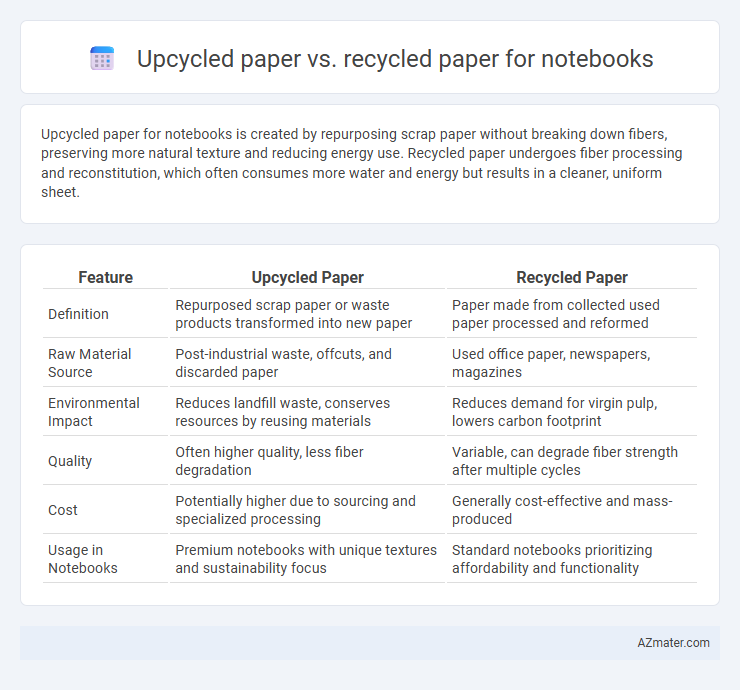Upcycled paper for notebooks is created by repurposing scrap paper without breaking down fibers, preserving more natural texture and reducing energy use. Recycled paper undergoes fiber processing and reconstitution, which often consumes more water and energy but results in a cleaner, uniform sheet.
Table of Comparison
| Feature | Upcycled Paper | Recycled Paper |
|---|---|---|
| Definition | Repurposed scrap paper or waste products transformed into new paper | Paper made from collected used paper processed and reformed |
| Raw Material Source | Post-industrial waste, offcuts, and discarded paper | Used office paper, newspapers, magazines |
| Environmental Impact | Reduces landfill waste, conserves resources by reusing materials | Reduces demand for virgin pulp, lowers carbon footprint |
| Quality | Often higher quality, less fiber degradation | Variable, can degrade fiber strength after multiple cycles |
| Cost | Potentially higher due to sourcing and specialized processing | Generally cost-effective and mass-produced |
| Usage in Notebooks | Premium notebooks with unique textures and sustainability focus | Standard notebooks prioritizing affordability and functionality |
What is Upcycled Paper?
Upcycled paper for notebooks is created by transforming discarded paper products or other waste materials into new, high-quality paper without breaking them down to the pulp stage, preserving fibers and reducing energy consumption. This process minimizes environmental impact by diverting waste from landfills and requiring fewer resources compared to traditional recycling methods. Upcycled paper often retains unique textures and appearances, making it a sustainable and aesthetically appealing choice for eco-conscious stationery.
What is Recycled Paper?
Recycled paper is made from used paper products that have been collected, cleaned, and processed into new paper material, reducing the need for virgin pulp and conserving natural resources. This eco-friendly option retains the quality and durability required for notebooks while minimizing environmental impact such as deforestation and waste accumulation. Compared to upcycled paper, recycled paper utilizes post-consumer waste specifically designed to enter the paper production cycle again.
Key Differences Between Upcycled and Recycled Paper
Upcycled paper for notebooks is created by repurposing waste materials such as old posters or packaging, reducing the need for additional processing and preserving fibers in their original state. Recycled paper, on the other hand, involves breaking down used paper products into pulp and reforming it, which often requires chemical and mechanical treatments that can degrade fiber quality. Key differences include environmental impact, fiber strength, and production processes, with upcycled paper generally offering a lower carbon footprint and more distinctive textures compared to conventional recycled paper.
Environmental Impact: Upcycling vs. Recycling
Upcycled paper for notebooks reduces environmental impact by repurposing existing materials without extensive processing, thereby saving energy and water compared to traditional recycling methods. Recycling paper involves breaking down fibers and reprocessing, which consumes more resources and generates emissions. Choosing upcycled paper supports a lower carbon footprint and less waste, contributing to more sustainable notebook production.
Paper Quality and Durability Comparison
Upcycled paper notebooks often retain higher quality fibers by repurposing pre-consumer waste, resulting in smoother texture and fewer contaminants compared to recycled paper, which typically uses post-consumer waste with mixed fiber content. The durability of upcycled paper is generally superior due to less fiber degradation during processing, offering stronger sheets that resist tearing and wear better over time. Recycled paper notebooks may show more variation in fiber strength and surface finish, impacting long-term usability and overall user experience.
Production Processes Explained
Upcycled paper for notebooks is produced by creatively repurposing waste materials such as fabric scraps or agricultural residues, minimizing the need for new raw pulp and reducing environmental impact significantly. Recycled paper, on the other hand, is made by collecting and processing used paper products through cleaning, deinking, and re-pulping to create new sheets, which conserves trees and reduces landfill waste. Both methods involve energy and water use, but upcycling often requires less processing and fewer chemicals, making it a more sustainable option in the production process.
Cost Analysis: Upcycled vs. Recycled Notebooks
Upcycled paper notebooks often cost less to produce than recycled paper notebooks due to lower processing requirements and reduced need for bleaching or chemical treatments. Recycled paper involves energy-intensive deinking and pulping processes that increase manufacturing expenses. Choosing upcycled paper notebooks can result in significant cost savings while supporting sustainable material reuse in stationary products.
Creative Designs and Aesthetic Appeal
Upcycled paper notebooks showcase unique textures and patterns derived from repurposed materials, enhancing creative design possibilities and offering a distinct aesthetic appeal compared to traditional recycled paper. Recycled paper typically presents a more uniform look but allows for eco-friendly printing techniques that maintain clarity and vibrancy in notebook designs. The choice between upcycled and recycled paper directly influences the tactile experience and visual impact, appealing to consumers seeking originality or sustainability in their stationary products.
Choosing the Right Option for Sustainability
Upcycled paper for notebooks reduces waste by repurposing materials that would otherwise be discarded, offering a lower environmental footprint compared to traditional recycled paper, which requires energy-intensive processes to break down and reform fibers. Choosing upcycled paper supports circular economy principles and minimizes the use of virgin resources, making it a highly sustainable option for eco-conscious consumers. Evaluating the production methods, carbon emissions, and resource consumption of each can guide buyers toward the most environmentally responsible notebook choice.
Future Trends in Eco-Friendly Notebooks
Upcycled paper notebooks are gaining traction as a future-forward choice, utilizing materials that would otherwise be discarded, thereby reducing waste and environmental impact more significantly than traditional recycled paper. Innovations in eco-friendly notebook production emphasize not only post-consumer fiber reuse but also low-energy processing and the incorporation of organic inks and biodegradable covers. As consumer demand for sustainable products grows, upcycled paper notebooks are expected to dominate the market by offering enhanced environmental benefits along with unique textures and aesthetic qualities.

Infographic: Upcycled paper vs Recycled paper for Notebook
 azmater.com
azmater.com